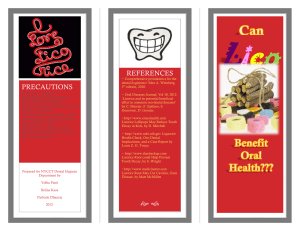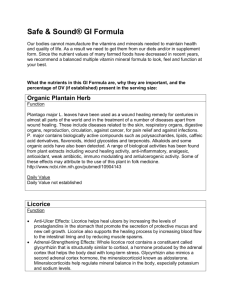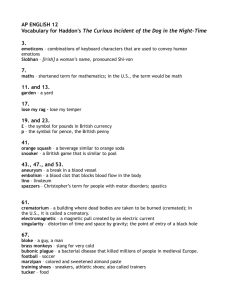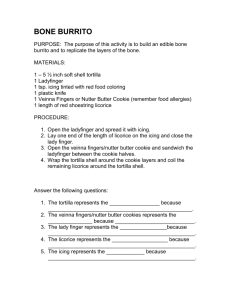Full Text
advertisement
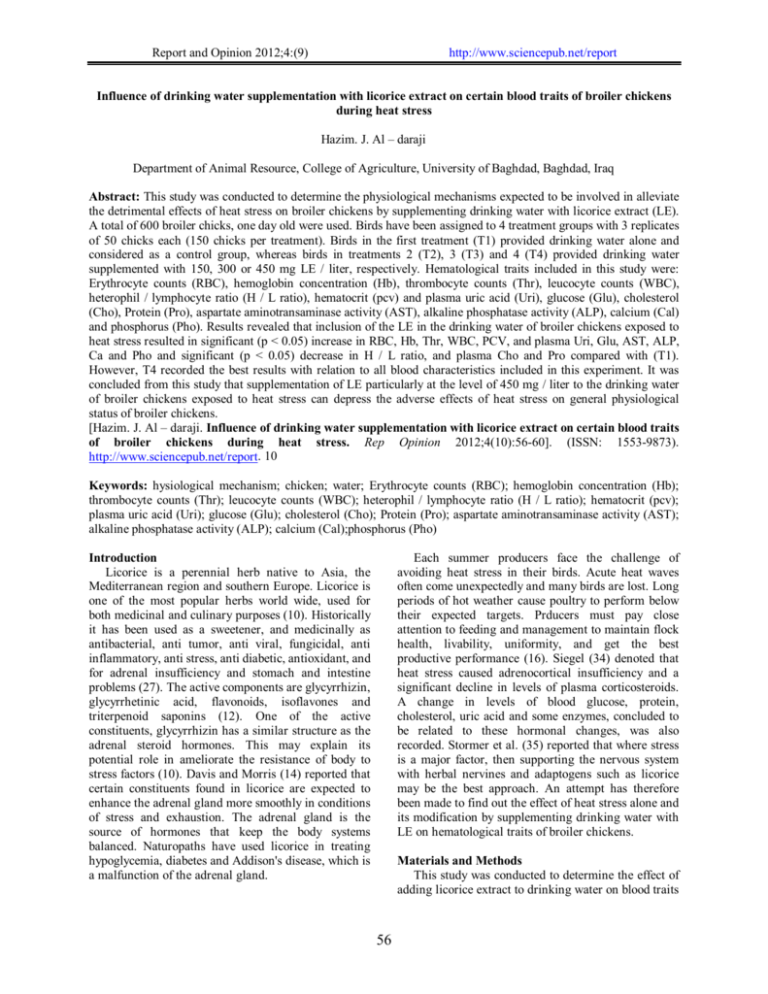
Report and Opinion 2012;4:(9) http://www.sciencepub.net/report Influence of drinking water supplementation with licorice extract on certain blood traits of broiler chickens during heat stress Hazim. J. Al – daraji Department of Animal Resource, College of Agriculture, University of Baghdad, Baghdad, Iraq Abstract: This study was conducted to determine the physiological mechanisms expected to be involved in alleviate the detrimental effects of heat stress on broiler chickens by supplementing drinking water with licorice extract (LE). A total of 600 broiler chicks, one day old were used. Birds have been assigned to 4 treatment groups with 3 replicates of 50 chicks each (150 chicks per treatment). Birds in the first treatment (T1) provided drinking water alone and considered as a control group, whereas birds in treatments 2 (T2), 3 (T3) and 4 (T4) provided drinking water supplemented with 150, 300 or 450 mg LE / liter, respectively. Hematological traits included in this study were: Erythrocyte counts (RBC), hemoglobin concentration (Hb), thrombocyte counts (Thr), leucocyte counts (WBC), heterophil / lymphocyte ratio (H / L ratio), hematocrit (pcv) and plasma uric acid (Uri), glucose (Glu), cholesterol (Cho), Protein (Pro), aspartate aminotransaminase activity (AST), alkaline phosphatase activity (ALP), calcium (Cal) and phosphorus (Pho). Results revealed that inclusion of the LE in the drinking water of broiler chickens exposed to heat stress resulted in significant (p < 0.05) increase in RBC, Hb, Thr, WBC, PCV, and plasma Uri, Glu, AST, ALP, Ca and Pho and significant (p < 0.05) decrease in H / L ratio, and plasma Cho and Pro compared with (T1). However, T4 recorded the best results with relation to all blood characteristics included in this experiment. It was concluded from this study that supplementation of LE particularly at the level of 450 mg / liter to the drinking water of broiler chickens exposed to heat stress can depress the adverse effects of heat stress on general physiological status of broiler chickens. [Hazim. J. Al – daraji. Influence of drinking water supplementation with licorice extract on certain blood traits of broiler chickens during heat stress. Rep Opinion 2012;4(10):56-60]. (ISSN: 1553-9873). http://www.sciencepub.net/report. 10 Keywords: hysiological mechanism; chicken; water; Erythrocyte counts (RBC); hemoglobin concentration (Hb); thrombocyte counts (Thr); leucocyte counts (WBC); heterophil / lymphocyte ratio (H / L ratio); hematocrit (pcv); plasma uric acid (Uri); glucose (Glu); cholesterol (Cho); Protein (Pro); aspartate aminotransaminase activity (AST); alkaline phosphatase activity (ALP); calcium (Cal);phosphorus (Pho) Each summer producers face the challenge of avoiding heat stress in their birds. Acute heat waves often come unexpectedly and many birds are lost. Long periods of hot weather cause poultry to perform below their expected targets. Prducers must pay close attention to feeding and management to maintain flock health, livability, uniformity, and get the best productive performance (16). Siegel (34) denoted that heat stress caused adrenocortical insufficiency and a significant decline in levels of plasma corticosteroids. A change in levels of blood glucose, protein, cholesterol, uric acid and some enzymes, concluded to be related to these hormonal changes, was also recorded. Stormer et al. (35) reported that where stress is a major factor, then supporting the nervous system with herbal nervines and adaptogens such as licorice may be the best approach. An attempt has therefore been made to find out the effect of heat stress alone and its modification by supplementing drinking water with LE on hematological traits of broiler chickens. Introduction Licorice is a perennial herb native to Asia, the Mediterranean region and southern Europe. Licorice is one of the most popular herbs world wide, used for both medicinal and culinary purposes (10). Historically it has been used as a sweetener, and medicinally as antibacterial, anti tumor, anti viral, fungicidal, anti inflammatory, anti stress, anti diabetic, antioxidant, and for adrenal insufficiency and stomach and intestine problems (27). The active components are glycyrrhizin, glycyrrhetinic acid, flavonoids, isoflavones and triterpenoid saponins (12). One of the active constituents, glycyrrhizin has a similar structure as the adrenal steroid hormones. This may explain its potential role in ameliorate the resistance of body to stress factors (10). Davis and Morris (14) reported that certain constituents found in licorice are expected to enhance the adrenal gland more smoothly in conditions of stress and exhaustion. The adrenal gland is the source of hormones that keep the body systems balanced. Naturopaths have used licorice in treating hypoglycemia, diabetes and Addison's disease, which is a malfunction of the adrenal gland. Materials and Methods This study was conducted to determine the effect of adding licorice extract to drinking water on blood traits 56 Report and Opinion 2012;4:(9) http://www.sciencepub.net/report of broiler chickens during heat stress. A total of 600 broiler chicks, one day old were reared on floor pens. Chicks were distributed at random among four treatment groups with three replicates per treatment, with 50 chicks per replicate. The ad libitum dietary regimen consisted of starter diet containing 22.7% crude protein and 3067.4 K cal ME / kg of diet (0 to 3 wk) and a finisher diet containing 20.6% crude protein and 2922 K cal ME / kg of diet (4 to 8 wk). Birds in the first group (T1) provided drinking water alone and considered as a control group, while birds in treatments 2 (T2), 3 (T3) and 4 (T4) received drinking water supplemented with 150, 300 or 450 mg LE / liter, respectively. At the third week of age, birds in all treatments were exposed to heat stress (38 – 43 º C) for 6 hours daily (1200 h – 1800 h). The period of heat exposure was continued until the end of experiment (8th week of age). Gas brooders were used as a source of heat exposure in the experimental house. However, the supplementation of LE to the drinking water of birds was also started at the third week of age and continued until 56 day of age. At the end of experiment (8 weeks of age), blood samples were collected into a vascular (containing heparin) by brachial vein puncture of 30 birds in each treatment. The hematological characteristics evaluated in the present experiment and which have shown to indicate general physiological status of birds consisted of the following (method in parenthesis): Erythrocyte counts – RBC (28), hemoglobin concentration – Hb (36), thrombocyte counts – Thr (2), leukocyte counts – WBC (28), heterophil to lymphocyte ratio – H / L ratio (23), hematocrit – PCV (4), and plasma uric acid – Uri (24), plasma glucose – Glu (6), cholesterol – Cho (20), protein – Pro (37), aspartate aminotransaminase activity – AST (31), alkaline phosphatase activity – ALP (36), calcium – Cal (26), and phosphorus – Pho (18). Data were subjected to an ANOVA using the General Linear Models (GLM) procedure of SAS (32). Significant treatment means were separated by using the multiple range test of Duncan (15). as blood purifier and enhancer, licorice cleanses the blood as well as enhances its' cells by increasing the nutrient value of food material within the body. By enhancing corticosteroids activity, glycyrrhizin helps to increase energy, ease stress, and reduce the symptoms of ailments sensitive to corticosteroid levels, such as chronic fatigue syndrome and fibromylagia. In the 1800s, LE was a common remedy for a type of persistent fatigue known as neurasthenia, the condition now as chronic fatigue syndrome (22). Modern research on LE had report effects which are included: adrenal enhancing, anti allergic, blood cells enhancing (both red and white), bone marrow enhancing, anti inflammatory, antioxidant, Central Nervous System depressant and immune potentiating (13). Oliff (29) reported that licorice can help reduce inflammation. It seems to prevent the breakdown of adrenal hormones such as cortisol (the body's primary stress – fighting adrenal hormone), making these hormones more available to the body. Licorice also appears to enhance immunity by increasing WBC via stimulate their production in production sites in the body and by boosting levels of interferon, a key immune system chemical that fights of attacking viruses. Addition of LE to the drinking water of broiler chickens caused a significant (p < 0.05) decrease in H / L ratio compared with control group. Furthermore, T4 recorded the lowest value for this trait in comparison with other treatments of LE (Table 1). Gross and Siegel (23) reported that H / L ratio measures a physiological changes, whereas the concentration of corticosteroids in the blood is affected by many factors before physiological changes occur. The H / L ratio should be a better measure of long - term changes in the environment, and the concentration of corticosteroids in the blood should be a better measure of short – term changes. Therefore, the H / L ratio is a good measure of the chicken's perception in its environment, and increasing H / L ratio indicated that the birds were under acute stress (1). Plasma Uri, Glu, Pro, and AST exhibited differences among treatment groups (Table 2). Plasma Uri, Glu, and AST were higher while plasma Pro was lower in LE treatments (T2, T3 and T4) than control group (T1). Siegel (34) reported that of many effects attributed to corticosteroids, the most fundamental are those on metabolic processes. Corticosteroids increase plasma Glu and enhance glycogenolysis. The gluconeogenesis is from labile Pro as is indicated by an increase in non protein nitrogen, a decrease in the incorporation of Glu carbon into Pro,decrease in plasma Pro and an increase in Uri excretion . The higher corticosteroid level increases the transaminase activities (30). The increase in AST activity in chicken during stress might be under the influence of higher corticosteroid level. The α – Results and Discussion Results revealed that birds exposed to heat stress and provided drinking water supplemented with LE had significantly (p < 0.05) higher RBC, Hb, Thr, WBC, and PCV values than birds provided drinking water with no added LE (Table 1). Significant increases in these trait values were obtained with increasing LE level. However, T4 recorded the highest means as regards these characteristics in comparison with all other treatments included in this experiment. These results may be explained by that licorice has properties similar to corticosteroids and ACTH hormones and hence its role in reinforcement the resistance of body to stress (33). Armanini et al. 95) reported that by acting 57 Report and Opinion 2012;4:(9) http://www.sciencepub.net/report keto acids produced by transamination of amino acids provided an important source of substrate for gluconeogenesis (11). However, Baker (7) reported that glycyrrhetenic acid, the steroid like constituent of glycyrrhizic acid, inhibits an enzyme responsible for inactivating corticosteroid in the kidney. The treatment with licorice essentially extends the lifetime of corticosteroids and hence enhances the resistance of body to stress. Siegel (34) reported that if the stressor continues to be strong and persistent and no escape is possible, the bird will enter the stage of exhaustion when its adrenals lose their ability to sustain glucocorticoids production and the result may be physical disability and death. Table 1. Effect of supplementing drinking water with LE on hematological traits of broiler chickens exposed to heat stress. Treatments TI T2 T3 T4 Traits RBC 2.28 ± 0.08 c 2.33 ± 0.08 b 2.45 ± 0.10 a 2.12 ± 0.11 d (X 106 / μL) Hb 7.17 ± 0.40 d 8.20 ± 0.37 c 8.28 ± 0.39 b 8.35 ± 0.39 a (g / dL) Thr 20.17 ± 0.87 d 20.55 ± 0.96 c 20.89 ± 1.01 b 21.51 ± 0.88 a (X 103 / μL) WBC 21.03 ± 0.67 b 21.37 ± 1.82 b 22.18 ± 2.77 a 20.69 ± 0.74 c (X 103 / μL) H/L 0.28 ± 0.009 a 0.25 ± 0.008 b 0.23 ± 0.010 b 0.20 ± 0.009 c Ratio PCV 18.18 ± 1.97 d 20.69 ± 1.00 c 21.05 ± 0.88 b 22.27 ± 0.85 a (%) T1: Control group, T2, T3 and T4: Birds received drinking water supplemented with 150, 350 or 450 mg LE / liter, respectively. * Values in the raw with different letters differ significantly (p < 0.05). Table 2. Effect of supplementing drinking water with LE on blood plasma traits of broiler chickens exposed to heat stress. Treatments TI T2 T3 T4 Traits Uric acid 7.52 ± 0.40 c 7.71 ± 0.43 b 7.89 ± 0.51 ab 8.02 ± 0.45 a (mg / dL) Glucose 160.12 ± 22.18 d 163.23 ± 19.47 c 166.03 ± 20.11 b 169.45 ± 20.37 a (mg / dL) Cholesterol 134.67 ± 16.33 b 133.05 ± 14.87 c 130.28 ± 15.25 d 136.46 ± 15.72 a (mg / dL) Protein 5.15 ± 0.27 a 5.03 ± 0.29 b 4.97 ± 0.31 b 4.86 ± 0.33 c (g / dL) AST 96.96 ± 10.9 c 97.20 ± 11.3 b 97.56 ± 10.4 a 96.03 ± 9.88 d (IU / liter) ALP (King Armstrong 36.47 ± 4.50 c 37.00 ± 4.63 b 38.61 ± 5.17 a 38.69 ± 5.22 a unit) Calcium 7.25 ± 0.38 b 7.97 ± 0.55 a 8.01 ± 0.91 a 6.15 ± 0.75 c (mg / dL) Phosphorus 3.01 ± 0.10 d 3.35 ± 0.28 c 3.75 ± 0.18 b 3.91 ± 0.22 a (mg / dL) T1: Control group, T2, T3 and T4: Birds received drinking water supplemented with 150, 350 or 450 mg LE / liter, respectively. * Values in the raw with different letters differ significantly (p < 0.05). 58 Report and Opinion 2012;4:(9) http://www.sciencepub.net/report Results also revealed that the addition of LE to the drinking water of broiler chickens resulted in significant (p < 0.05) decrease in plasma Cho compared with control group (Table 2). Furthermore, T4 recorded the lowest value concerning this trait in comparison with other treatments used in the present study. This result may be explained by the hypocholesterolemia property of licorice (21). Bensky and Gamble (9) reported that in China LE was traditionally used as anti asthmatic, anti inflammatory, aldosterone – like and cortisone enhancing, anti ulcer and blood cholesterol lowering action. Licorice has been shown to reduce low density lipoprotein and cholesterol. The active components of licorice inhibit the formation of lipid peroxides and protect low density lipoprotein associated carotenoids (8). Compared to control group, plasma ALP, Cha, and Pho were significantly (p < 0.05) increased by LE treatments (T2, T3 and T4; Table 2). The improvement in these traits noticed in our study by treating the birds with LE could be as a result of LE properties in which it suppressing or limiting the damaging effects of stress (14). Al – Daraji et al. (3) found that treated the broiler chickens exposed to heat stress with probiotic or LE resulted in significant improvement in mean body weight, feed conversion ratio, cumulative weight gain, livability, Productive Index, Economic Figure and dressing percentage ass compared with control group and potassium chloride and sodium bicarbonate treatments. Moreover, LE treatment surpasses probiotic treatment with respect to mean body weight, weight gain, cumulative feed consumption, livability and dressing percentage. Hoffman (2004) reported that licorice is one of a group plants that have a marked effect upon the endocrine system. The glycosides present have a structure that is similar to the natural steroids of the body. They explain the beneficial action that licorice has in counteracting the deleterious effects of stress and in the treatment of adrenal gland problems. Both licorice extract and glycyrrhetinic acid are shown to have desoxycorticosterone and ACTH – like effects, though with less toxicity than cortisone, encouraging its use as an anti – stress agent (17). Studies have shown that glycyrrhizin stimulates the excretion of hormones by the adrenal cortex. Some researches have suggested it as possible drug to prolong the action of cortisone. Glycyrrhizin has a similar chemical structure to corticosteroids released by the adrenals, and further studies have been suggested that it might one day prove useful in improving the function of hormone drugs, or be used as an aid in helping to reduce withdrawal symptoms from dependency on some corticosteroid hormones (19). In conclusion, hematological traits were significantly affected by heat stress exposure. The addition of LE to the drinking water significantly recovered the adverse effects of heat stress on hematological parameters of broiler chickens. The protective effect of 450 mg LE / liter (T4) used in this experiment against the noxious effects of heat stress was greater than that of 150 (T2) and 300 mg LE / liter (T3). These improvements in blood characteristics could contribute to a solution of heat stress problem in broiler chickens. References 1. Al – Daraji, H. J.; B. T. O. Al – Tikriti and A. A. Al – Rawi (2002). Study of the hematological traits of Indigenous cocks reared during summer months. Iraqi J. Agric. Sci., 33(2): 233 – 238. 2. Al – Daraji, H. J.; I. A. Abdul – Hassan; K. M. Abdul – Latif and F. A. Al – Obaidi (2001). An evaluation of dietary nettle Urtica urens supplementation on some physiological traits of broilers. Veterin., 11(1): 14 – 26. 3. Al – Daraji, H. J.; I. A. Al – Ani; J. K. Minati and S. A. Mukhlis (2006). Comparison of licorice extract, probiotic, potassium chloride and sodium bicarbonate for their effects on productive performance of broiler chicken exposed to heat stress. Accepted for publication in the Iraqi J. Agric., 11(2). 4. Archer, R. K. (1965). Haematological Techniques for use on Animas. Oxford: Blackwell Scientific Publications. 5. Armanini, D.; I. Karbowiak and J. W. Funder (1983). Affinity of liquorice derivatives for mineralcorticoid and glucocorticoid receptors. Clin. Endocrinol., 19: 609 – 612. 6. Asatoor, A. M. and E. J. King (1954). Simplified colorimetric blood sugar method. Biochem J., 56: 44 – 46. 7. Baker, M. E. (1994). Licorice and enzymes other than 11 – beta – hydroxysteroid dehydrogenase: an evolutionary perspective. Steroids, 59 (2): 136 – 141. 8. Belinky, P. A.; M. Aviram; B Fuhrman; M. Rosenblat and J. Vaya (1998). The antioxidative effects of the isoflavan glabridin on endogenous constituents of LDL during its oxidation. Atherosclerosis, 137 (1): 49 – 61. 9. Bensky, L. and J. Gamble (1993). Chinese Herbal Medicine; Materia Medica. Revised edition, Eastland Press, Seattle, Wash. 10. Bown, D. (1995). Encyclopedia of Herbs and their Uses. Dorling Kindersley, London. ISBN 0 – 7513 – 020 – 31. 11. Chatterjee, S.; A. K. Chakraborty; B. N. Roy; S. P. Ghosh and M. Chatterjee (1979). A note on the effect of heat stress on certain enzyme activities in domestic duck (Anas platyrhyncos) in captive 59 Report and Opinion 2012;4:(9) 12. 13. 14. 15. 16. 17. 18. 19. 20. 21. 22. 23. 24. http://www.sciencepub.net/report terrestrial environment. Indian J. Anim. Sci., 49 (7): 591 – 593. Chevallier, A. (1996). The Encyclopedia of Medicinal Plants. Dorling Kindersley, London. ISBN 9 – 780751 – 303148. Daniel, R. (1995). A handbook of Chinese Healing Herbs. Shambhala Pub., Boston, Mass. Davis, E. A. and D. J. Morris (1991). Medicinal uses of licorice through the millennia: the good and plenty of it. Mol. Cell Endocrinol. 78: 1 -6. Duncan, D. B. (1955). Multiple range and multiple F test. Biometrics, 11: 1 – 42. Ferket, P. A. (1992). Hot Weather Management and Feeding of Poultry. Takeda, U. S. A., INC., Corporate Drive, Orangeburg, New York. Farese, R. V.; E. G. Biglieri and C. H. L. Shakelton (1990). Licorice – induced hypermineralcorticolism. N. Engl. J. Med., 325 (17): 1223 – 1227. Fiske, C. H. and Y. Subbarow (1982). Determination of inorganic phosphour in serum and urine. In: Fundamentals of Clinical Chemistry. Ed. Tietz, N. W., W. B. Saunders Company, London. Foster, S. (2005). Licorice. www. stevenfoster. com / education / monograph / licorice. html. Franey, R. J. and A. Elias (1968). Serum cholesterol measurement based on ethanol extraction and ferric chloride – sulfuric acid. Clin. Chem. Acta, 2: 255 – 263. Fuhrman, B.; N. Volkova and M. Kaplan (2002). Anti atherosclerotic effects of licorice extract supplementation on hypercholesterolemic patients: increased resistance of LDL to atherogenic modifications, reduced plasma lipid levels, and decreased systolic blood pressure. Nutrition, 18 (3): 268 – 273. Grieve, A. (2004). Licorice. www. wholehealthmd. com / refshelf / substances _ view / 1, 1525, 801, 00. html. Gross, W. B. and H. S. Siegel (1983). Evaluation of the heterophil / lymphocyte ratio as a measure of stress in chickens. Avian Dis., 27: 972 – 979. Henry, R. J.; C. Sobel and J. Kim (1982). Determination of uric acid. In: Fundamentals of 25. 26. 27. 28. 29. 30. 31. 32. 33. 34. 35. 36. 37. 2/26/2012 60 Clinical Chemistry. Ed. Tietz, N. W., W. B. Saunders Company, London. Hoffman, D. L. (2004). Liquorice. www. healthy. net / library / books / hoffman / material medical / liquorice. Htm. Kramer, B. and F. F. Tisdall (1982). Determination of serum calcium by oxalate precipitation and redox titration. In: Fundamentals of Clinical Chemistry. Ed. Tietz, N. W., W. B. Saunders Company, London. Leung, A. Y. and S. Foster (1996). Encyclopedia of Common Natural Ingredients Used in Foods, Drugs and Cosmetics. 2nd ed, John Wiley & Sons, New York. Natt, M. P. and C. A. Herrick (1952). A new blood diluent for counting the erethrocytes and leucocytes of the chicken. Poultry Sci., 31: 735 – 738. Oliff, H. S. (2005). Licorice (Glycyrrhiza glabra). www. herbalgram. org. O'Riordan, J. L. H.; P.G. Malan and R. P. Gould (1982). Essential of Endocrinology. Blackwell Scientific Publication, London. Reitman, S. and S. (1957). A colorimetric method for the determination of serum glutamic oxaloacetic and glutamic pyruvic transaminase. Am. J. Clin. Path., 28: 56 – 65. SAS (1996). SAS User's Guide: Statistics Version, 6th edn., SAS Institute Inc., Cary, NC. Shibata, S. (2000). A drug over the millennia: pharmacognosy, chemistry, and pharmacology of licorice. [Review]. Yakugaky Zasshi., 120 (10): 849 – 862. Siegel, H. S. (1995). Stress, strains and resistance. Br. Poultry Sci., 36: 3 – 22. Stormer, F. C.; R. Reistad; J. Alexander (1993). Glycyrrhizinic acid in liquorice – evaluation of health hazard. Food Chem. Toxicol., 31: 303 – 312. Varley, H.; A. H. Gowenlock and M. Bell (1980). Practical Clinical Biochemistry. 5th ed. William Heinemann Medical Books Ltd. Wotton, I. D. P. (1964). Micro – Analysis in Medical Biochemistry. 4th ed. Churchill Livingston, London.
